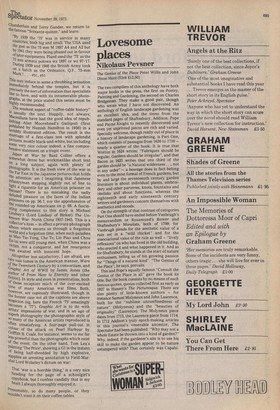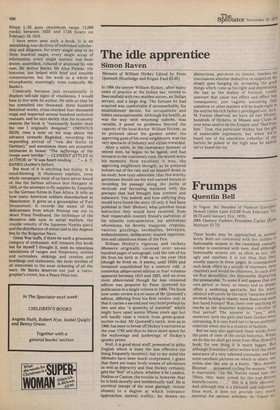Lovesome places
Nikolaus Pevsner
The Genius of the Place Peter Willis and John Dixon Hunt (Elek E12.50) The two compilers of this anthology have both major books in the press, the first on Poetry, Painting and Gardening, the second on Charles Bridgeman. They make a good pair, though who wrote what I have not discovered. An anthology of English landscape gardening was an excellent idea, and the items from the standard pages of Shaftesbury, Addison, Pope and Payne Knight to recently discovered and even yet unprinted pieces are rich and varied. Specially welcome, though really out of place in a history of landscape gardening, is Part One, which consists of passages from 1620 to 1710 — nearly a quarter of the book. It is true that Wotton in 1624 writes: "Fabriques should be regular, Gardens should be irregular", and that Bacon in 1625 writes that one third of the garden should be "a Natural wilderness ..., not in any order" — a boscage does in fact belong even to the most formal of French gardens, but by and large the seventeenth century garden literature is about individual plants, embroidery and other parterres, knots, fountains and obelisks and about functions, whereas the eighteenth and early nineteenth century writers and gardeners concern themselves with aesthetics and moods.
On the strength of that contrast of categories Part One should have ended before Vanbrugh's memorandum or Rosamund's Bower and Shaftesbury's Moralists, both of 1709; for Vanbrugh pleads for the aesthetic value of a ruin set in a "wild thicket" and for the associational value of the ruin as well — "lively reflexions" on who has lived in the old building, who erected it and what happened in it. And as for Shaftesbury, he stands at the start of nature enthusiasm, telling us of his growing passion for "Things of a natural kind". "The Genius of the Place", he says, prevails.
This and Pope's equally famous "Consult the Genius of the Place in all" gave the book its title. But the book consists by no means of such famous quotes, quotes collected first as early as 1927 in Hussey's The Picturesque. There are also plenty of little-known authors — for instance Samuel Molyneux and John Laurence, both for the "sublime unconfinedness of nature" (Molyneux) and the "beauties of originality" (Laurence). The Molyneux piece dates from 1713, the Laurence piece from 1714. In 1712 Addison's truly epoch-making articles in this journal's venerable ancestor, The Spectator had been published: "Why may not a whole Estate be thrown into a kind of garden?" Why, indeed, if the gardener's aim is to use his skill to make the garden appear to be nature untampered with? That certainly was Capabi lItY .Brown's aim, but he started only when Addison had been dead thirty years. Brown was rn in 1715, Horace Walpole who called Brown Da.me Nature's Second Husband" in 1717. Brown and Walpole (whose History of the Modern Taste in Gardening was first printed in 1772) mark the climax of mid-Georgian landscaping. Brown and Walpole, and that enigma Whately. When was he born? How did he develop? His Observations on Modern 9urdening were written in 1765 and published In 1770, and he died in 1772. The style of his descriptions is as brilliant as Price's a generah. on later. When Jefferson travelled in England In 1786 to visit country houses and their parks, he had Whately's book with him, and he judged that English gardening "surpasses all the
earth".
Jefferson's travel notes are almost entirely factual. "A lovely mixture of concave and Convex" — Kent's park of Esher Place — iS a rare exception. Kent, it is known, created the style which Capability Brown handled supremely. But by 1786 the Brown style was beginning to be criticised. Sir William Chambers's somewhat embarrassing Dissertation on Oriental Gardening (of 1772) does not Want "vulgar Nature" and objects to "digging holes to raise mole-hills". He pretends to prefer 111-formed trees, gibbets, vultures and jackals an 'Shocks of electrical impulses". Richard Payne Knight in his The Landscape, In 1794, is more serious: Brown to him represents "everlasting green" — "dull, vapid, smooth". 1794 is also the date of IJvedale Price's tI. rst Essay. Knight and Price are Late Georgian In their faith in roughness, seeming neglect, !yen decay. Yet — and this is one of the most interesting passages — Joseph Warton in The Enthusiast in 1744 already praises the "Pinet°Pt Precipice, abrupt and shaggy" and e2t.c1aims "Can Stowe ... such Raptures raise?" His answer is, no. Part Four of Messrs Hunt and Willis's book deaIS with 1772 to 1816, and fills about fifty Pages. It is too short to do full justice to Knight, to Price, to Repton and also to Gilpin. For
Gilpin the editors ought to have chosen a piece to show his presentation of real nature, not of parks. I would also have welcomed passages from Thomson's Liberty, to demonstrate the connection of political freedom with landscape gardening. On the whole, however, poetry is amply quoted, thanks of course to Mr Dixon Hunt's prime concern with literature.
It will be evident from my review that there is much to praise in this book. There is little seriously to object to. Bibliographical references and some annotations to the fifty-nine items ought to have been provided. The bibliography at the end is somewhat idiosyncratic. Miles Hadfield's A History of British Gardening, for example, does not appear in it. However, if Johannes Dobai's Die Kunsttiteratur des Klassizismus und der Romantik in England — over 2,000 pages — gets no mention, the reason is of course that it came out too late.
Krupp L/35 guns (maximum range 12,000 yards) between 1635 and 1728 hours on February 19, 1915.
I have never seen such a book. It is an astonishing tour-de-force of individual scholarship and diligence, for every single map in its three hundred pages, every single scrap of information, every single statistic has been drawn, assembled, collated or analysed by one man, Mr Arthur Banks. Mr Alan Palmer, the historian, has helped with brief and sensible commentaries, but the work as a whole is triumphantly, stunningly, even comically Mr Banks's.
Comically because just occasionally it displays tell-tale signs of crankiness. I would hate to live with its author. He tells us that he has consulted one thousand, three hundred historical works, cross-checked four-thousand maps and inspected several hundred technical manuals, and he says darkly that for economy reasons the book is "necessarily briefer than the one I originally designed," OMINOUS SIGN, cries a note on his map about the advance towards Baghdad, recording the impending arrival of "von der Goltz (a Gerinan)," and sometimes there are eccentric intimacies in boxes: "The sufferings of the troops were terrible" — CLEMENT ATTLEE to AUTHOR, or "It was heart-rending . ." — A. T. BANKS (Author's father).
But most of it is anything but funny. It is mind-blowing. It illustrates exploits, even whole campaigns most of us have never heard .of, like the Serbian advance into Hungary in 1918, or the attempts to fly supplies by Zeppelin to the German forces in East Africa. It tells us how many American soldiers disembarked at Manchester. It gives us a groundplan of Fort Douaumont. It records the name of the delicatessen from which Princep ran out to shoot Franz Ferdinand, the technique of the deceptive side turn in aerial warfare, the muzzle velocity of the Japanese Nambu pistol and the distribution of mines laid in the Aegean Sea by the Bulgarian Navy.
Great War buffs, if there be such a gruesome category of enthusiast, will treasure this book but for myself I thought it, with its relentless tabulations of ranges and firepowers, sorties and surrenders, sinkings and crashes and bombings and stalemates, the most terrible of all memorials to the most sickening of all the wars. Mr Banks deserves not just a cartographer's crown, but a Peace Prize too,




































 Previous page
Previous page